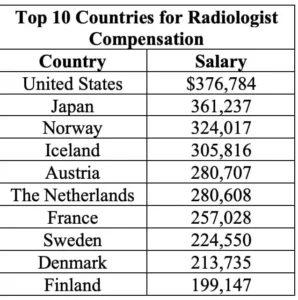
Introduction
As the field of interventional radiology (IR) continues to expand, understanding the nuances of interventional radiology salary becomes increasingly important for both practitioners and healthcare organizations. This comprehensive guide delves into the multifaceted factors influencing IR salaries, average compensation trends, and strategies for maximizing earning potential in this dynamic specialty.
Table of Contents
Factors Influencing Interventional Radiology Salary:
1. Experience and Expertise
- Radiologists’ compensation often correlates with their years of experience and level of expertise in performing intricate interventional procedures.
- Seasoned interventional radiologists with a robust skill set and extensive procedural proficiency typically command higher salaries than their less experienced counterparts.
2. Geographic Disparities
- Geographic location significantly impacts IR salaries, with variations observed across different regions and metropolitan areas.
- Urban centers and regions with high costs of living, such as New York City, San Francisco, and Los Angeles, generally offer more lucrative compensation packages to offset the higher expenses.
3. Practice Setting and Institutional Resources
- The type of practice setting, whether academic medical centers, private hospitals, or outpatient clinics, influences IR salaries.
- Academic institutions and large healthcare systems may offer competitive salaries and comprehensive benefits packages to attract top talent, while private practices may provide incentives such as profit-sharing opportunities.
4. Subspecialty Focus
- Subspecialty expertise in areas such as neurointerventional radiology, vascular interventions, and interventional oncology can significantly impact salary prospects.
- Radiologists with specialized training and proficiency in high-demand subspecialties often command premium compensation due to their unique skill sets and contributions to patient care.
5. Board Certification and Credentials
- Board certification in interventional radiology signifies a radiologist’s commitment to excellence and proficiency in the field.
- Certified interventional radiologists may enjoy higher salaries, increased job opportunities, and greater recognition within the medical community.
6. Academic and Research Involvement
- Academic affiliation and involvement in research, teaching, or administrative roles may augment IR salaries and provide additional sources of income.
- Radiologists engaged in academic medicine often receive compensation for scholarly activities, publications, and leadership positions within their institutions.
7. Market Demand and Job Outlook
- The demand for interventional radiologists varies based on factors such as population demographics, healthcare trends, and technological advancements.
- Areas experiencing shortages of interventional radiologists may offer more competitive salaries and attractive employment packages to recruit and retain talent.
- Radiologists can leverage market demand trends to negotiate favorable compensation agreements and explore job opportunities in high-demand regions or subspecialty areas.
8. Negotiation Strategies and Contract Considerations
- Negotiating a competitive salary and benefits package is essential for maximizing earning potential in interventional radiology.
- Radiologists should research industry benchmarks, assess their unique qualifications and contributions, and articulate their value proposition during salary negotiations.
- Considerations such as call responsibilities, productivity expectations, performance incentives, and work-life balance should also be addressed in employment contracts to ensure mutual satisfaction and professional fulfillment.
9. Continuing Education and Professional Development
- Investing in ongoing education and professional development is integral to advancing in the field of interventional radiology and increasing earning potential.
- Pursuing subspecialty training, participating in research projects, and obtaining additional certifications or advanced degrees can enhance radiologists’ expertise and marketability.
- Staying abreast of emerging technologies, procedural innovations, and best practices through conferences, workshops, and online resources is essential for maintaining competitiveness and delivering high-quality patient care.
10. Long-Term Financial Planning and Career Growth
- Long-term financial planning is critical for interventional radiologists to secure their financial well-being and achieve their professional goals.
- Radiologists should consider factors such as retirement savings, investment strategies, disability insurance, and estate planning to safeguard their financial futures.
- Exploring opportunities for career advancement, leadership roles, and practice ownership can provide avenues for increasing earning potential and achieving personal and professional fulfillment over the course of their careers.
Average Interventional Radiology Salary
- Data from industry surveys and professional organizations offer insights into average IR salaries in the United States.
- According to the latest MGMA Physician Compensation and Production Survey, median annual compensation for interventional radiologists ranges from $370,000 to $700,000, reflecting variations based on geographic location, experience, and practice setting.

Conclusion
- Interventional radiology presents a lucrative and fulfilling career path for radiologists seeking opportunities in a rapidly evolving field.
- By understanding the multifactorial determinants of IR salaries and strategically navigating career choices, radiologists can optimize their earning potential and contribute to advancing patient care in this dynamic specialty.
Commonly Asked Questions about "Interventional Radiology Salary"
- The average salary for interventional radiologists varies depending on factors such as experience, geographic location, and practice setting. According to industry data, the median annual compensation ranges from $500,000 to $700,000.
- Several factors influence interventional radiology salaries, including experience, geographic location, practice setting, subspecialty expertise, board certification, academic affiliation, and market demand.
- Interventional radiology salaries vary across different regions and metropolitan areas. Urban centers and regions with high costs of living generally offer higher salaries compared to rural areas.
- Yes, subspecialty certifications, such as in neurointerventional radiology, vascular interventions, or interventional oncology, can significantly impact interventional radiology salaries by enhancing expertise and marketability.
- Entry-level interventional radiologists typically earn salaries commensurate with their experience and skill level. While exact figures vary, entry-level salaries for interventional radiologists often exceed those of other medical specialties.
- Interventional radiologists can negotiate higher salaries by leveraging their experience, expertise, academic achievements, and market demand trends. Researching industry benchmarks, understanding contract terms, and highlighting unique qualifications during negotiations are essential.
- Academic affiliations may lead to higher interventional radiology salaries due to additional income sources such as teaching, research grants, and scholarly activities. However, salary disparities exist based on individual institutions and academic ranks.
- Salary prospects for interventional radiology fellows vary based on factors such as training program reputation, subspecialty training, geographic location, and academic affiliation. Fellows may expect competitive salaries upon completing their training.
- Interventional radiology salaries are generally competitive compared to other medical specialties. Factors such as procedural complexity, demand for specialized skills, and advancements in technology contribute to interventional radiologists’ earning potential.
- Interventional radiologists can expect steady salary growth over the course of their careers, particularly with subspecialty expertise, academic achievements, and leadership roles. Continued professional development, research involvement, and market demand trends also influence long-term salary prospects.

